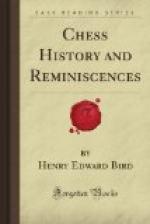Such consideration as can be found devoted to the game or games of the Egyptians mainly relates to hypothesis and conjectures in regard to the inscriptions recorded to have been discovered on tombs and the temples generally, and especially on the wall of the great palace of Medinet Abu at Egyptian Thebes, which, according to the most approved authorities, derived from the scrolls, relates to the time of Ramesses Meiammun the 16th, out of the 17 monarchs of the 18th dynasty, who as is supposed, reigned from 1559 to 1493 B.C., and constructed Medinet Abu, and is pronounced most likely to be the monarch represented on its walls. His title is Ramses, and he is considered to have been the grandfather of Sesostris 1st of the 19th dynasty, whose reign is stated as from 1473 to 1418 B.C.
Some discussion arose in chess circles in 1872 in reference to Mr. Disraeli’s mention of chess in one of his books. Chapter 16 of “Alroy” begins—“Two stout soldiers were playing chess in a coffee-house,” and Mr. Disraeli inserts on this the following note (80). On the walls of the palace of Amenoph ii, called Medinet Abuh, at Egyptian Thebes, the King is represented playing chess with the Queen. This monarch reigned long before the Trojan war.
A writer, who styled himself the author of Fossil Chess, in criticising the above, refers to Sir Gardiner Wilkinson’s work, “A popular account of the ancient Egyptians, which declares the game to resemble draughts, the pieces being uniform in pattern.” The same critic further remarks, “In the same work may be found some account of the paintings in the tomb of Beni Hassan, presumably the oldest in Egypt, dating back from the time of Osirtasen I, twenty centuries before the Christian era, and eight hundred years anterior to the reign of Rameses III, by whom the temple of Medinet Abuh was commenced, and who is the Rameses portrayed on its walls. An unaccountable error on Mr. Disraeli’s part in the same note assigns its erection to Amenoph ii, who lived 1414 B.C.
The eminent and revered writer and statesman may not have selected the supposed best authorities for his dates, but the sapient critic indulges in a strange admixture of misconception. However, Egyptian chronology is not fully agreed upon, even Manetho and Herodotus differ some 120 years as to the time of Sesostris, and Bishop Warburton, we read, was highly indignant with a scholar, one Nicholas Man, who argued for the identity of Osiris and Sesostris after he (the bishop) had said they were to be distinguished. Respecting English origin, all authorities down to the end of the Eighteenth century agreed in ascribing the first knowledge of chess to the time of William the Conqueror, or to that of the return of the first Crusaders.
Perhaps, however, it reached us in the days of Charlemagne, and may well have done so through Alcuin of York, his friend and tutor in the reigns of Offa and of Egbert.
Al Walid, 705-715; Harun, 786-809; the great Al Mamun, 813 to 833; and Tamerlane, 1375 to 1400, are monarchs who honoured their chess opponents when beaten. Charlemagne, 768-814, seems also to have taken defeat good-humouredly, and Queen Elizabeth, who liked chess, philosophised upon it. Canute, William the Conqueror, and Henry the Eighth, like the famous Ras, of Abyssinia, whom Salt and Buckle inform us of, preferred to win.




